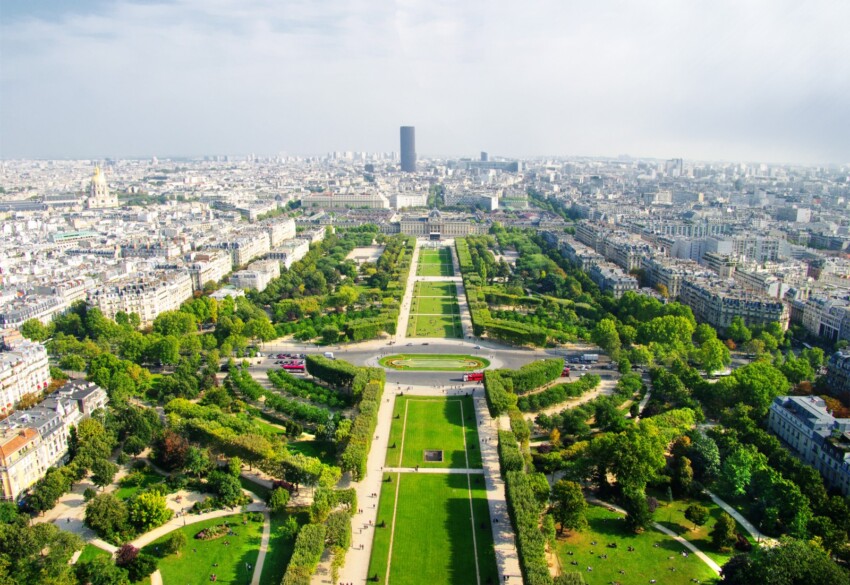

Located in the centre of Paris, in the 7th arrondissement, with its surface area of almost 25 hectares, the Champ-de-Mars is one of the largest green spaces in Paris: it stretches from the Trocadero esplanade to the Ecole Militaire.
This vast public garden is certainly a busy place throughout the year, but what makes it a must-see is the presence of the French capital’s most famous symbol, the Eiffel Tower.
A landmark for major national events, the park is freely accessible and offers the most beautiful view of the capital’s iconic monument. Parisians and tourists alike gather on its lawns to picnic, listen to music and, at night, admire the sparkle of the Eiffel Tower.

Originally, it was a countryside area, where horticulture was practised. Later, the construction of the Ecole Militaire in 1765 determined its natural destination as a space for military use.
For this reason, its name was meant to recall the armed forces: in fact, it derives from the Roman Field of Mars, and thus from the god of war, to indicate the vast public space that in Roman cities was dedicated to military manoeuvres and parades. In fact, the size of the Champ-de-Mars de Paris allowed it to gather up to 10,000 men in order of battle. It was then enclosed by large wrought-iron gates and became the setting for some of the Revolution‘s greatest celebrations.
Later, this immense public space was converted to civilian use and was designed to create a series of large, airy avenues of plane trees intertwined with parallel and perpendicular paths, in order to instil a vast sense of depth and highlight the monuments that the park surrounds.
The French-style structure blends perfectly with the English style, creating small but charming green niches where visitors can relax.
Walking along the avenues of this vast garden, one can admire rare and exceptionally large trees, such as the pterocarya, the tallest in the park (37 metres), the largest and oldest of the gutta-percha trees (1904), the tallest (18 metres) and the oldest of the white mulberry trees with grey-brown cracked bark (1904), the oldest of the Provence hackberry trees (1896), but also a yellow chestnut (1902), an Osage orange (1935), a persimmon, an Indian lilac, a parrotia himalayana with greenish-white flowers that bloom in April.
These large trees have attracted birds usually more inclined to the tranquillity of the woods, such as the greater spotted woodpecker, recognisable by its black, white and bright red plumage. But the most famous bird of the Champ-de-Mars is undoubtedly the tawny owl. Its silent flight and nocturnal stay make it almost invisible in the city.
There are numerous bronze statues hidden by the vegetation: the most famous is the bust of Gustave Eiffel, the mind who designed the Eiffel Tower, a 7,000-tonne giant whose avant-gardism shocked most French people of the time. The monument remained standing thanks to the genius of polytechnician and scholar Gustave Ferrié, whose bust still stands at the foot of the Tower, who had the idea of using its height for radio transmission.
Since 2000, the park has been enriched with a new attraction: the Peace Monument, a modern sculpture made of 32 columns and two glass structures. What makes the monument special is the word Peace, written in 32 languages using 18 different alphabets.
Parisian families take advantage of the green spaces of the Champ de Mars to play sports, share a picnic during the summer or simply to go on the rides, take the children for pony rides or attend a Guignol theatre show.
In the evenings, the Champ-de-Mars often becomes a favourite venue for big concerts, especially in summer, when the weather is still mild and the lawns crowded.
The most eagerly awaited event, by locals and tourists alike, is certainly the one that takes place every year on the evening of 14 July, on the occasion of the French National Holiday: thousands of people flock to watch the great fireworks display at 11 p.m., always preceded by a major concert, different every year.
Champ de Mars is located in the 7th arrondissement, on the left bank of the Seine. The surrounding district is full of restaurants, patisseries and quaint shops, a place to mingle with the locals.
It can be easily reached by public transport using the metro, line 8, stop École Militaire or line 6 stop Bir-Hakeim, Dupleix.
Alternatively, you can choose the RER, line C, stop Campo di Marte – Tour Eiffel or buses 42, 69, 87, 82, 92, 28 or 80.
If you like walking and want to enjoy the wonderful view of the Eiffel Tower, you can also get off at the Trocadero metro station (lines 6 and 9) and continue on foot.
Champ de Mars is located in the 7th arrondissement, on the left bank of the Seine, at the Eiffel Tower.
City Card allow you to save on public transport and / or on the entrances to the main tourist attractions.
